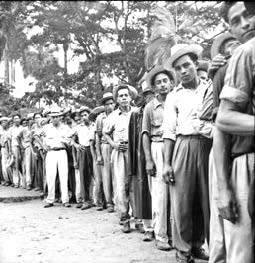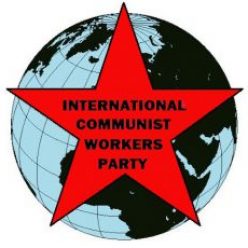Causes of Migration and the Revolutionary Alternative of ICWP here ♦ Learning from History of Class Struggle in Central America here ♦

Banana Workers Strike, 1954
The Historical Causes of Migration and the Revolutionary Alternative of the Workers in ICWP
EL SALVADOR— “Now my sister is facing difficult conditions,” said a worker at a vaccination center. They were talking about the latest United States Supreme Court ruling against immigrants in Temporary Protected Status (TPS). The only way to stop this type of measure is by fighting for a communist system. Where we workers have no borders, where money doesn’t exist, nor sexism or racism. Where we produce based on the needs of society and not for the bosses’ profits. This will be achieved through the struggle organized by the International Communist Workers’ Party.
Recently the US Vice President visited Guatemala and Mexico as part of her international tour to address the causes of migration to the USA from Central America and Mexico.
One of her most iconic phrases was “Do not come.” In this, Kamala Harris dealt a heavy blow to the thousands of workers who daily try to cross the US southern border because of the misery caused by exploitation and organized violence (gangs, drug trafficking). In addition, she flirted with the Republican voters in her country, who consider the option of the southern border wall to be the definitive solution to migration.
The attacks against workers continue by the governments in Mexico and in the so-called “Northern Triangle” of Guatemala, El Salvador and Honduras. Workers face super-exploitation, attacks on environmental defenders, on those who fight for access to drinking water in the poorest communities in the region, especially on women. People have died in the struggle against metal mining.
“They are the same as Republicans; they deport more people,” a friend from the healthcare area said as we talked a little about the issue. In her speech Harris intentionally hid, for her interests, the historical causes of migration to the United States.
Demanding justice, impartiality, is incompatible with the capitalist system. The rulers’ elections are based on the investment of millions of dollars in campaigns and advertising. At the level of social networks, too, those who are behind these campaigns and candidates are business people who bet on “X” or “Y” electoral party to run the State in turn.
As the communist leader Lenin said, “The oppressed are allowed once every few years to decide which particular representatives of the oppressing class shall represent and repress them.”
The comrades in the factories, schools and universities must understand that our only alternative is communist revolution.
The situation is very difficult for workers, both in the United States and in Central America. We cannot get rid of this horror without first overthrowing the capitalist system. And this will be achieved by recruiting more workers and soldiers for our Party in all the places where we are making progress.
We need to build networks of politically and socially active workers with the objective of building revolutionary power as an alternative to the capitalist state. That means communist cells that organize workers to face organized crime and the economic and political crises typical of capitalist states.
Millions of people united in seeking the common welfare and the protection of their families, to guarantee a dignified life for all: that is the fight for communism.
Let us refocus the disenchantment of masses of urban workers and farmworkers with electoral politics towards the political formation and building of collectives that mark the starting point of the struggle for world communist revolution.
Let’s organize the International Communist Workers’ Party!
Learning from the History of Class Struggle in Central America: Workers’ Struggles Have No Borders
Guatemalans “Thinking about making that dangerous trek to the United States-Mexico border: Do Not Come.” Many around the world were furious.
Over more than a century, US imperialism has created the conditions from which people throughout the region are fleeing.
In Guatemala and Honduras, the US-owned United Fruit Company (UFC) owned the land, the railroads, the electric company, and the government. One example among many: Under Guatemalan President Jorge Ubico (1931-1944), indigenous people were forced to carry passbooks. If they violated the “vagrancy” laws, they had to work for UFC.
Ubico’s fascist repression led to mass anger. He was replaced by liberals, including Jacobo Arbenz Guzmán. Arbenz believed that land reform would establish the basis for a modern capitalist economy. In 1952, his government confiscated a huge chunk of uncultivated UFC land.
Amidst the Cold War, it wasn’t hard for the US Secretary of State and the CIA Director to red-bait Arbenz. The CIA trained, financed, and armed a group led by Carlos Castillo Armas that overthrew the Guatemalan government in June 1954. Both officials, the brothers Alan and John Foster Dulles, had been lawyers for the UFC. That shows the real basis of the coup.
More than nine thousand Guatemalan supporters of Arbenz were arrested. Castillo outlawed unions, gave the land back to the UFC, and instituted a reign of terror which has effectively never ended.
This history explains a lot about imperialism, why people migrate, and why so many are angry at Kamala Harris.
As the story is usually told, the UFC, the CIA and Castillo are the bad guys, the democratically elected capitalist reformer Arbenz is the good guy, and the masses are simply victims.
In the real story, the struggle of the masses of workers takes center stage. It’s the story of the communist-led strike of banana workers in neighboring Honduras in May-June 1954. This strike against the same United Fruit Company led to a 69-day general strike.
Workers organized secretly in the banana camps and struck over pay and working conditions. The strike spread to the ports and the cities, where workers walked out in support and over their own demands.
They organized strike committees in all six centers of UFC. Workers’ committees maintained order (including shutting down the bars). They organized food, shelter, propaganda, and the extension of the strike to other areas. Strikers took over Ramon Rosas Park in El Progreso. They set up loudspeakers and used the park as the center of strike organization, food distribution, and agitation.
The strikers outnumbered the soldiers in the Honduran Army. That may explain why there was no general repression. Further, the communist leaders limited themselves to the organization of a union. The strike was over by July.
Honduran communists had been active earlier in the 20th century in a Central American-wide Communist Party. The Honduran Communist Party itself was organized during the strike with probably about two hundred members. It followed the political guidance of the Soviet Union.
The Soviet Union was by then advocating peaceful coexistence with capitalism. It had abandoned the armed struggle for state power, and communists in Honduras had no strategy for that. They and communists elsewhere defined themselves as militant trade union leaders. During the 1954 General Strike, they helped lead the collective struggle of the masses, but they didn’t advocate communist or even anti-imperialist politics.
Today we don’t make that mistake.
We are inspired by the militant history of communist organizers in Honduras, and around the world. The workers’ committees that were set up during the strike are a microcosm of the communist society we fight for today.
But we don’t organize trade-union struggles that bargain for the terms of our exploitation. We fight for a communist world, without exploitation, and without borders. And we will win.

